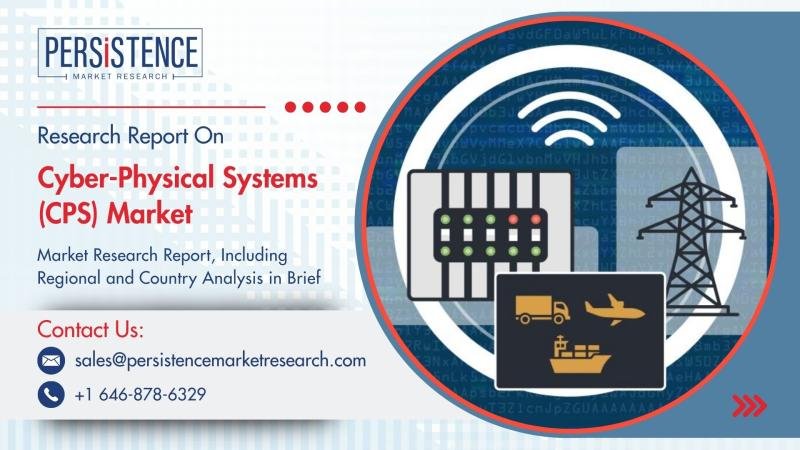✅Market Overview: Understanding the Growth of Cyber-Physical Systems
The global Cyber-Physical Systems (CPS) market is set for explosive growth over the next decade. According to Persistence Market Research, the market is expected to grow from US$ 111.21 billion in 2024 to US$ 277.01 billion by 2031, expanding at a CAGR of 13.9% during the forecast period. This impressive trajectory is fueled by the increasing convergence of physical processes with digital systems, enabled through advanced sensors, actuators, and real-time data analytics.
At the core of CPS are embedded systems that integrate computational algorithms with physical processes, making them crucial for sectors like healthcare, manufacturing, automotive, and aerospace. As industries adopt Industry 4.0 and smart technologies, the demand for CPS is growing steadily. The hardware segment, including sensors and actuators, dominates the market due to the essential role these components play in creating interactive, intelligent systems. Geographically, North America leads the global CPS market, driven by robust investments in automation, advanced infrastructure, and early adoption of innovative technologies in the U.S. and Canada.
Get a Sample PDF Brochure of the Report (Use Corporate Email ID for a Quick Response): https://www.persistencemarketresearch.com/samples/35011
✅Key Highlights from the Report
➤ The CPS market is projected to reach US$ 277.01 Bn by 2031 from US$ 111.21 Bn in 2024.
➤ North America is the largest regional market, driven by digital transformation across sectors.
➤ Hardware components, particularly sensors and actuators, hold the largest market share.
➤ Closed-loop systems are gaining popularity due to their efficiency in adaptive environments.
➤ Manufacturing and automotive remain the top verticals deploying CPS technologies.
➤ Asia Pacific is expected to witness the fastest growth rate during the forecast period.
✅Market Segmentation: Breaking Down the CPS Ecosystem
The cyber-physical systems market is segmented by component, type, and vertical, each playing a crucial role in shaping the overall ecosystem. By component, the market is categorized into hardware, software, and services. Hardware, which includes sensors, actuators, and computational nodes, is the largest contributor, as these are fundamental to system functionality. Software, meanwhile, enables system intelligence, while services offer customization and integration solutions.
By type, CPS is divided into open-loop and closed-loop systems. Closed-loop systems, which involve continuous feedback and adaptive control, are seeing higher adoption in precision-driven environments like automated manufacturing and autonomous vehicles. Open-loop systems, while simpler, still hold relevance in scenarios where feedback isn’t critical.
In terms of verticals, industries such as healthcare, manufacturing, automotive, agriculture, energy & utilities, and aerospace & defense are the primary consumers of CPS. Among them, manufacturing leads the pack due to increasing factory automation and predictive maintenance solutions. The automotive sector follows closely, driven by the growing development of autonomous driving technologies and smart transportation systems.
✅Regional Insights: Market Performance Across the Globe
North America continues to dominate the CPS market owing to high investment in technological infrastructure and widespread adoption of smart industrial practices. The United States, in particular, is a hub for CPS innovation due to its deep-rooted presence in manufacturing automation, smart cities, and defense systems. Regulatory support and funding for smart infrastructure projects further drive market growth in this region.
On the other hand, Asia Pacific is emerging as the fastest-growing region in the global CPS market. Countries such as China, Japan, and South Korea are investing heavily in industrial digitization and IoT integration. The rise of smart factories, combined with favorable government initiatives like “Made in China 2025” and “Society 5.0” in Japan, is propelling regional growth. This region is also witnessing a boom in smart agriculture and renewable energy management using CPS technologies.
✅Market Drivers Fueling Growth
The growing implementation of Industry 4.0 initiatives is a primary catalyst for the CPS market. Smart factories powered by real-time data, interconnected machines, and automation are increasingly dependent on CPS to function efficiently. Furthermore, the rapid advancement of IoT, AI, and machine learning technologies has made CPS more intelligent, cost-effective, and scalable.
Healthcare is another driver, with wearable medical devices and robotic surgeries becoming more common. These rely on cyber-physical systems to monitor and respond to real-time data, enhancing patient outcomes. In addition, the rise of smart grid systems and autonomous vehicles are further expanding the scope and investment in CPS solutions across sectors.
✅Market Restraints Hindering Expansion
Despite its potential, the CPS market faces some limitations. One of the most significant barriers is cybersecurity. As these systems collect and process sensitive data, they become prime targets for cyberattacks, necessitating robust and often expensive security protocols. Additionally, the complexity and cost of deployment, especially for small and medium-sized enterprises (SMEs), can be a significant hurdle.
Another restraint is the lack of standardized protocols and interoperability among CPS platforms. This can lead to integration challenges when combining products from different vendors or upgrading legacy systems, slowing down adoption rates in conservative or budget-constrained sectors.
✅Market Opportunities on the Horizon
The ongoing expansion of smart city projects globally presents vast opportunities for CPS vendors. These systems are pivotal in managing urban infrastructure such as traffic, water supply, energy consumption, and public safety through real-time decision-making. Similarly, the agricultural sector is embracing precision farming, where CPS-enabled drones, sensors, and analytics platforms help optimize crop yields and resource use.
There’s also rising demand for edge computing in CPS architecture. Edge processing reduces latency and enhances system responsiveness, making it ideal for applications such as autonomous vehicles and industrial robotics. As industries shift toward sustainable and efficient solutions, CPS will be at the core of future innovation across verticals.
For Customized Insights on Segments, Regions, or Competitors, Request Personalized Purchase Options @ https://www.persistencemarketresearch.com/request-customization/35011
✅Frequently Asked Questions (FAQs)
➤ How Big is the Cyber-Physical Systems (CPS) Market?
➤ Who are the Key Players in the Global Market for Cyber-Physical Systems?
➤ What is the Projected Growth Rate of the CPS Market?
➤ What is the Market Forecast for Cyber-Physical Systems for 2032?
➤ Which Region is estimated to dominate the Cyber-Physical Systems Industry through the Forecast Period?
✅Company Insights: Key Players in the CPS Market
✦ ABB Group
✦ Siemens AG
✦ General Electric
✦ Rockwell Automation
✦ Honeywell International
✦ Bosch Rexroth
✦ Schneider Electric
✦ Mitsubishi Electric
✦ Intel Corporation
✦ Cisco Systems
✦ Samsung Electronics
✦ Hitachi, Ltd.
✅Recent Developments
■ In 2024, Siemens AG launched an AI-powered CPS platform designed for predictive maintenance in large-scale manufacturing plants.
■ Honeywell International partnered with a leading healthcare company to integrate CPS into patient monitoring and emergency response systems.
The Cyber-Physical Systems (CPS) market is poised for remarkable growth, reshaping industries with its ability to unify physical and digital processes. From enabling smart factories to powering autonomous vehicles and healthcare innovations, CPS is at the heart of the next industrial revolution. As technology continues to evolve, investing in CPS offers not only efficiency but also a strategic edge in a connected, intelligent future.
✅Explore the Latest Trending “Exclusive Article” @
• https://www.linkedin.com/pulse/exploring-future-connected-living-room-market-webrank-media-eaugf/
• https://medium.com/@apnewsmedia/how-smart-devices-are-transforming-the-living-room-experience-1ac039b098c4
• https://techxpresstoday.wordpress.com/2025/05/20/key-trends-driving-growth-in-the-connected-living-room-market/
• https://webrankmedia.blogspot.com/2025/05/the-impact-of-iot-on-modern-living-room.html
• https://vocal.media/stories/challenges-facing-the-connected-living-room-market-today
✅Contact Us:
Persistence Market Research
G04 Golden Mile House, Clayponds Lane
Brentford, London, TW8 0GU UK
USA Phone: +1 646-878-6329
UK Phone: +44 203-837-5656
Email: sales@persistencemarketresearch.com
Web: https://www.persistencemarketresearch.com
✅About Persistence Market Research:
At Persistence Market Research, we specialize in creating research studies that serve as strategic tools for driving business growth. Established as a proprietary firm in 2012, we have evolved into a registered company in England and Wales in 2023 under the name Persistence Research & Consultancy Services Ltd. With a solid foundation, we have completed over 3600 custom and syndicate market research projects, and delivered more than 2700 projects for other leading market research companies’ clients.
Our approach combines traditional market research methods with modern tools to offer comprehensive research solutions. With a decade of experience, we pride ourselves on deriving actionable insights from data to help businesses stay ahead of the competition. Our client base spans multinational corporations, leading consulting firms, investment funds, and government departments. A significant portion of our sales comes from repeat clients, a testament to the value and trust we’ve built over the years.
This release was published on openPR.


















